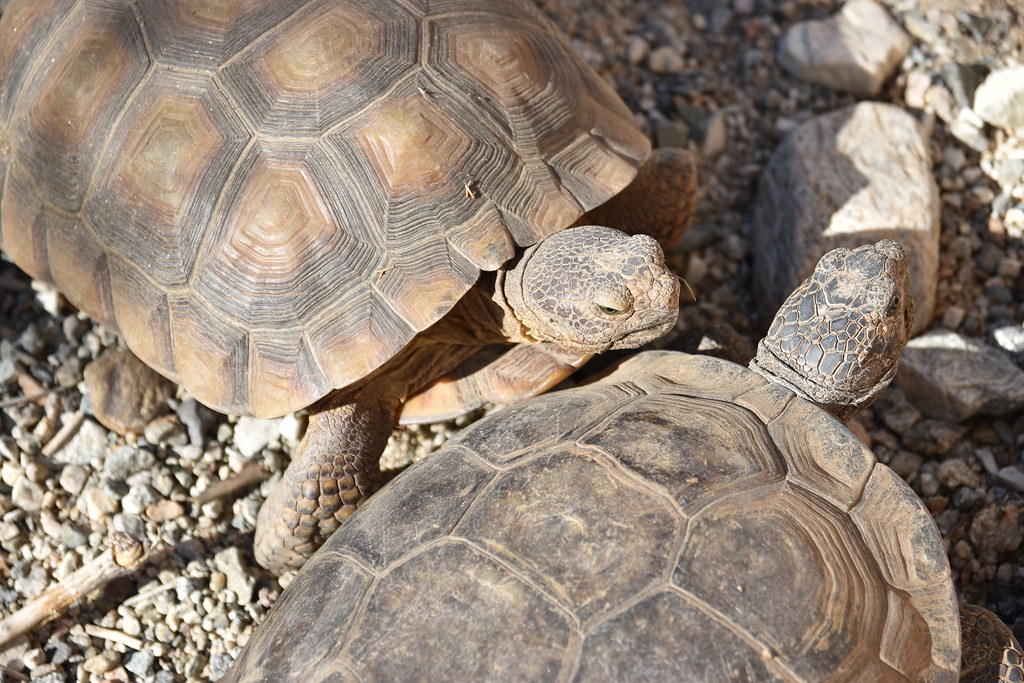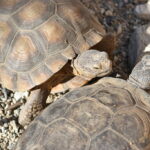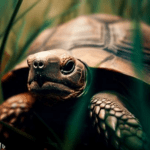
Image Source: Flickr
To gain a comprehensive understanding of why the desert tortoise is endangered, delve into the introduction section. Gain insight into the background on the desert tortoise species and an explanation of the factors contributing to its endangered status.
Key Takeaways
- The desert tortoise is endangered due to various factors such as habitat loss, predation, disease, and human activities.
- Habitat loss is a significant threat to the desert tortoise as urbanization and development encroach upon their natural habitats.
- Predation by non-native species, such as ravens and coyotes, has also contributed to the decline of the desert tortoise population.
- Disease, particularly a respiratory illness called upper respiratory tract disease (URTD), has had a devastating impact on the desert tortoise population.
- Human activities, including off-road vehicle use, illegal collection, and climate change, have further exacerbated the endangerment of the desert tortoise.
- Conservation efforts, such as habitat restoration, captive breeding programs, and public education, are crucial in protecting and recovering the desert tortoise population.
Background on the desert tortoise species
The desert tortoise species is a captivating creature! They live in arid regions and have evolved to survive extreme temperatures and scarce water sources. Their thick shells and ability to store water for long periods make them resilient to predators and the environment.
These creatures are also keystone species, playing a role in the seed dispersal of their ecosystem. This symbiotic relationship is why their habitats need to be preserved.
Remarkably, desert tortoises can live up to 80 years or more, making them an interesting study on aging for scientists. This is why it is essential to understand their significance and contribute to conservation efforts.
We must take action and support initiatives dedicated to protecting the desert tortoise species. Together, we can make sure future generations can witness the beauty and resilience of this incredible species!
Explanation of why the desert tortoise is endangered

The desert tortoise is endangered because of humans. Urbanization and land development destroy its habitat, leading to the loss of vital feeding and nesting grounds. This disrupts its natural life cycle.
Invasive species are also a problem. They compete with the tortoise for food and resources. They may even prey on young tortoises, which affects their population growth.
Climate change is a major threat too. Rising temperatures and droughts reduce food and water availability, making it hard for the tortoise to survive. Plus, these changes affect their reproductive behavior, impacting their ability to reproduce.
It’s important to help the desert tortoise. We can support conservation efforts and create awareness about their plight. This can encourage more people to help safeguard this unique reptile.
Habitat Loss
To understand the reasons behind the endangered status of the desert tortoise, delve into the section on habitat loss. Explore the description of its natural habitat and the discussion on how human activities have led to the loss of this critical environment for the tortoise to thrive.
Description of the desert tortoise’s natural habitat
The desert tortoise’s home is a dry place, full of different plants. It lives in deserts all across North America, where it has learned to survive in the heat.
It takes shelter in burrows or crevices when the sun gets too hot. Its hard shell helps keep the heat out and stores moisture. It eats plants like grasses, shrubs, and cacti.
Desert tortoises need certain plants for water in dry times. This shows how important the balance in the environment is for them.
We should protect these habitats from development. Making people aware of the tortoise’s role in nature can help.
Supporting conservation with government, science, and community partnerships will help keep the environment healthy.
By taking action and keeping the balance, we can make sure the desert tortoise has a bright future.
Discussion on how human activities have contributed to habitat loss
Human activities have had a huge impact on the disappearance of natural habitats. Urban areas growing, deforestation, farming, and industrialization have all caused great damage to different ecosystems around the world.
These activities have caused the destruction and breaking-up of habitats, making it hard for lots of plants and animals to survive. As cities develop and forests get cut down for human settlements and farms, the habitats that were once full of life become little fragments, not suitable for the various species that used to live there.
Industrialization has led to massive levels of pollution. Toxins released into the environment are contaminating water and ruining the balance of ecosystems. This pollution affects the aquatic life, and it even seeps into the soil, damaging the plants and all the other organisms in the food chain.
Also, humans taking too much from the environment is putting a lot of pressure on habitats. So much timber is being taken from forests that lots of creatures are losing their homes, and overfishing is leaving fewer and fewer marine creatures and upsetting the food chain in the sea.
We need to do something urgently to stop the loss of habitats. We all need to work together – governments, organizations, communities, and individuals – to put sustainable plans in place that protect and restore habitats. Planting trees will help to fix some of the damage done.
By saving our habitats, we can let species survive in their natural habitats. If we don’t act now, we could cause permanent damage that future generations will regret not stopping. Let’s act now to stop the loss of habitats before it’s too late. We can make a change and make sure future generations have a healthy planet to live on.
Climate Change
To better understand climate change and its impact on the desert tortoise population, delve into how this environmental phenomenon affects the species. Gain insights into the challenges the desert tortoise faces due to climate change through specific examples. Uncover the complexities of this issue and its implications for the survival of these remarkable creatures.
Explanation of how climate change affects the desert tortoise population
Climate change is a major issue for desert tortoises. Rising temperatures disturb their habitat, making food and shelter scarce. Droughts mean less water, and changing rainfall patterns mean fewer babies. A study in Joshua Tree National Park showed that higher temperatures from climate change have caused a shift in vegetation, reducing food for the tortoises and their population size.
Clearly, climate change is a huge threat to desert tortoises. To protect them and our planet, we must work to reduce greenhouse gas emissions. Sustainable practices and initiatives can help ensure a safe future for this species and for generations to come.
Examples of specific climate-related challenges for the species
Climate change poses serious challenges for species across the world. These challenges are mainly due to changing climate patterns, and can have a major impact on their survival.
For example:
- Polar bears – Melting sea ice makes it harder for them to find food.
- Coral reefs – Ocean temperatures cause coral bleaching, which leads to habitat loss and biodiversity decline.
- Arctic foxes – Shrinking snow cover reduces their camouflage during hunting, increasing risk of predation.
- Penguins – Changing wind patterns make it harder to find fish.
- Butterflies – Altered temperatures disrupt migration and breeding cycles.
- Elephants – Droughts cause water scarcity, leading to dehydration and conflict.
Other effects of climate change include rising sea levels that threaten turtles’ nesting sites, and heatwaves causing mass die-offs of fish.
A real-life example of the consequences of climate change is hummingbirds arriving at their usual stopover points to find empty nectar reserves due to shifts in flowering and fruiting times. This disruption in food availability puts their migration at risk.
These examples illustrate how climate change affects species. It emphasizes the need for global action to reduce its effects and save biodiversity.
Predation and Disease
To better understand the complex issue of predation and disease affecting the desert tortoise, explore an overview of the predators and diseases that impact this vulnerable species. Delve into the implications of predation and disease on the desert tortoise population, shedding light on the challenges it faces in its survival and conservation efforts.
Overview of predators and diseases that impact the desert tortoise

Predators and diseases are a critical part of desert tortoise fate, having direct and indirect effects on them. Coyotes, ravens, snakes, cats & dogs, all these native and non-native predators feast on the eggs, young & adults. Upper Respiratory Tract Disease (URTD) is a particular concern, caused by bacteria, leading to respiratory issues & increased susceptibility to other infections.
Toby’s story is a reminder of the challenges desert tortoises face. Toby was an egg when a coyote attacked; fortunately, a wildlife biologist relocated him to an incubator. Sadly, he contracted URTD due to exposure during captivity.
Predation and disease: Nature’s lethal combo, making population control a reality.
Discussion on the implications of predation and disease on the population
The effects of predation and disease on the animal population are huge. They mess with the balance of ecosystems, changing species composition and population dynamics. Predation can keep prey numbers in check, avoiding too many of them. Illness can reduce population size by killing animals or reducing how many babies they have. Predators often go for the ones already affected by disease. Predation can also indirectly influence disease transmission by changing where the animals go and what they do. It’s key to understand the relationship between predation and disease to manage wildlife and conservation well.
Conservation efforts: Animals thank us for saving them from predators and disease, though they’re secretly plotting our destruction – such is life!
Conservation Efforts
To address the issue of the endangered desert tortoise, dive into the section of conservation efforts. Discover the ongoing initiatives and organizations committed to its preservation. Explore the strategies implemented to protect this species, ensuring its survival in its natural habitat.
Description of ongoing conservation initiatives and organizations
Conservation is key to protecting our planet’s resources and wildlife. Efforts focus on preserving biodiversity, protecting endangered species, and promoting sustainable practices.
- Protected areas such as national parks and wildlife reserves provide safe habitats for species and help sustain ecological balance.
- The World Wildlife Fund (WWF) works globally to protect species and their habitats, as well as address climate change and sustainable development.
- Local grassroots organizations raise awareness and implement projects to tackle environmental challenges.
- Advanced technology also enables innovative conservation, like satellite tracking systems allowing scientists to monitor animal migrations.
Moreover, some organizations collaborate with indigenous communities to manage natural resources in a culturally-sensitive way.
Remember: Support conservation by donating or volunteering your time. Every effort counts for future generations! Conservation of desert tortoises is especially important since they move slowly – they need all the protection they can get!
Explanation of strategies being implemented to protect the desert tortoise
Trying to save the desert tortoise involves lots of different strategies. We must protect habitats by having protected areas with land-use regulations. We must also reduce threats from predators like ravens, by trapping, relocating, and controlling them.
Public education is also key, so we get local communities, schools, and tourists involved in tortoise conservation. We also work with landowners, government agencies, and environmental organizations to make sure our protection measures are effective.
For disease prevention, scientists do research to understand RTD and vaccinate against it. Lastly, we must limit off-road vehicle use in tortoise habitats. Establishing designated trails or restricted access zones will help protect the tortoises.
Summary of the key factors contributing to the desert tortoise’s endangered status
The endangered status of desert tortoises is due to many factors.
- Urban and agricultural development results in habitat loss.
- Non-native species like predators and invasive plants disrupt their ecosystem.
- Climate change and drought worsen the situation.
Additionally, illegal collection for the pet trade and road mortality add to their decline. To save them, we need to prioritize conservation. Establishing protected areas and stricter land use regulations will help. Raising awareness about their importance and responsible pet ownership should reduce illegal collection. A multi-faceted approach, involving government agencies, conservation organizations, and local communities, is necessary to ensure their future. Conservation efforts are essential if we want Mother Nature to give us the thumbs up!
Final thoughts on the importance of conservation efforts for preserving the species
Conservation efforts are hugely significant for preserving species. They help maintain biodiversity, protect ecosystems and guarantee the survival of endangered plants and animals. By conserving habitats and using sustainable practices, we can prevent further species loss and make our planet healthier.
One key reason why conservation is so important is biodiversity. Each species has its own unique role in an ecosystem. If one species is lost, it can upset the balance. By saving endangered species, we can keep the interconnected web of life on Earth safe.
Also, conservation efforts help maintain healthy ecosystems. These ecosystems offer us necessary services like clean air and water, rich soil for agriculture and natural resources. Without conservation, these ecosystems could be harmed by pollution, habitat destruction and other human activities.
Conservation is also vital for protecting endangered plants and animals. Many species are nearly extinct due to problems like habitat loss, poaching and climate change. By making protected areas and implementing conservation strategies, we give these species a chance to grow their populations.
So, how can we contribute to these conservation efforts? One way is to support organizations that focus on wildlife conservation. This could be through donations or voluntary work. These organizations work hard to protect habitats and endangered species.
Another suggestion is to use sustainable living habits in our daily lives. Small things like reducing waste, conserving energy and water and supporting sustainable agriculture can make a big difference in preserving species and their habitats.
We should also urge strong environmental policies at local, national and international levels. By raising awareness about the importance of conservation among policymakers and society, we can make sure enough measures are taken to protect our precious biodiversity.
Frequently Asked Questions
1. Why is the desert tortoise endangered?
The desert tortoise is endangered due to several factors, including habitat loss, predation, disease, and human activities. Urban development, off-road vehicle use, and livestock grazing have led to the destruction of the tortoise’s natural habitat. Predators such as ravens, foxes, and coyotes pose a threat to tortoise eggs and young tortoises. Additionally, diseases such as upper respiratory tract disease (URTD) have severely impacted tortoise populations.
2. How are humans contributing to the endangerment of desert tortoises?
Human activities play a significant role in the endangerment of desert tortoises. Urbanization and habitat destruction result in the loss of tortoise habitats, limiting their access to food, water, and shelter. The use of off-road vehicles in tortoise habitats can directly harm tortoises and destroy their burrows. Illegal collection for pet trade is another human-related factor that has contributed to the decline of tortoise populations.
3. What steps are being taken to protect the desert tortoise?
Various conservation efforts are being implemented to protect the desert tortoise. These include the establishment of protected areas, habitat restoration projects, captive breeding programs, and public education campaigns. Laws and regulations have been enacted to limit human activities that negatively impact tortoise populations, such as restricting off-road vehicle use and prohibiting the collection of tortoises from the wild.
4. Can captive breeding programs help save the desert tortoise?
Yes, captive breeding programs have the potential to help save the desert tortoise. These programs aim to increase the number of tortoises in controlled environments and reintroduce them into suitable habitats. They provide a safe environment for tortoise reproduction and protect the young from predators. However, it is important to ensure that the released tortoises can thrive in the wild and that the habitat is suitable for their long-term survival.
5. How can the public contribute to the conservation of desert tortoises?
The public can contribute to the conservation of desert tortoises by respecting their habitat and following guidelines set to protect them. Avoid disturbing tortoise burrows, refrain from releasing captive tortoises into the wild, and report any illegal activities that may harm tortoises or their habitats. Participating in volunteer programs and supporting organizations working towards desert tortoise conservation are also impactful ways to contribute.
6. Are there any laws protecting the desert tortoise?
Yes, there are laws in place to protect the desert tortoise. The desert tortoise is listed as a threatened species under the Endangered Species Act, meaning it is illegal to kill, harm, or harass them. Additionally, habitat areas critical to the tortoise’s survival are designated as critical habitat, providing further protection. Violations of these laws can result in significant fines and penalties.
Conclusion
To conclude, understand the significance of conservation efforts in preserving the endangered desert tortoise. Summarize the key factors responsible for its endangered status. Reflect on the importance of dedicated conservation actions to ensure the survival of this species.
References




